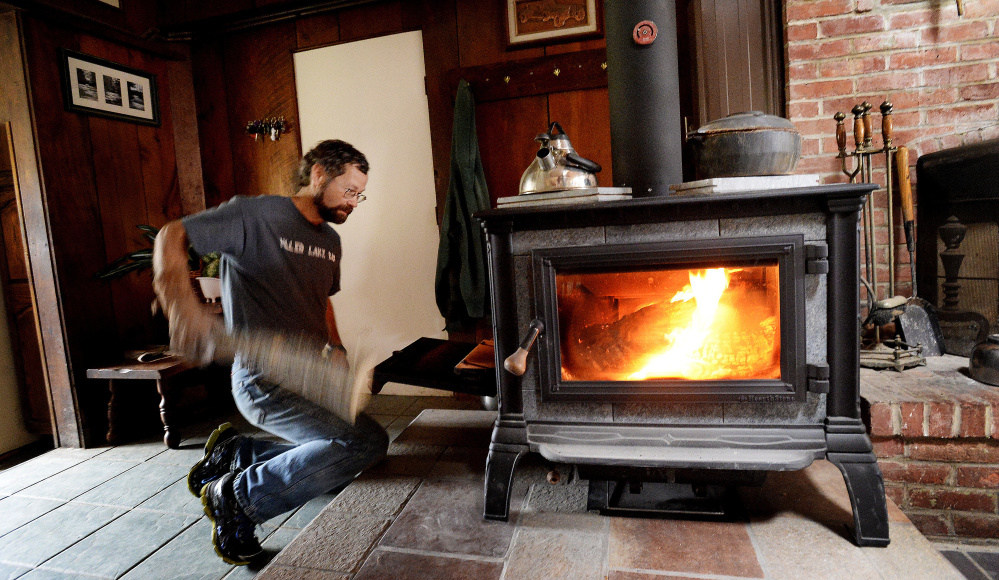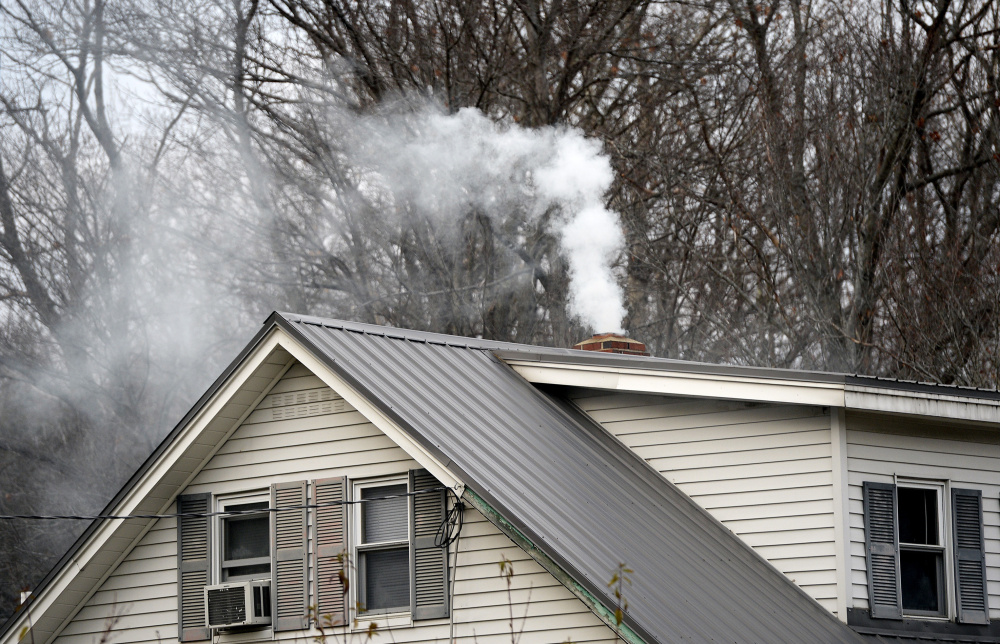PERU — A cold rain was falling from clouds draped across the Oxford Hills in early December. On a drive through the Androscoggin River valley, it was easy to see which homes are likely heated with wood. Dark smoke, trapped by the clouds, billowed from scattered chimneys along the route, an indicator of older stoves that burn inefficiently and release tiny particles into the air.
Steve and Marcia Fuller also heat with wood, but pulling up to their farmhouse in Peru, it’s harder to tell. White wisps of smoke rise from the chimney and disappear. Inside, a new wood stove that can emit roughly 70 percent less air pollution than the vintage model it replaced is radiating heat on the hearth.
The Fullers are among the first Mainers to receive $1,000 for scrapping their old wood burner and buying a new stove certified by the U.S. Environmental Protection Agency. They were able to take advantage of the first wood stove change-out program in Maine, sponsored by the American Lung Association.
This new program is a small one, confined to 10 towns in the Rumford area and funded with $41,000. Participants must agree to turn in their old stove and have a new wood, pellet or gas stove professionally installed in a chimney and hearth that meets safety codes. As of early December, only 26 homeowners who applied could qualify for the $1,000 voucher.
Electric heat pumps get a lot of buzz today as the clean-energy solution for Mainers looking for affordable warmth. But in the countryside, where money is tight and trees are plentiful, thousands of residents rely on older wood stoves to keep winter at bay. The exact numbers aren’t clear because wood often is a supplemental heat source, rising or falling with the price of fuel oil.
But there’s longstanding debate over the degree to which wood stove smoke contributes to lung disease, such as asthma. The Maine Department of Environmental Protection says it has calculated that wood smoke is responsible for roughly 20 percent of particle pollution statewide. The agency also notes that while an air monitor stationed in the Rumford area sometimes records elevated levels of particles in the air, readings in Oxford County have been falling since 2007. They now are below what the government considers harmful.
Having said that, the DEP is planning a new study on wood smoke next winter, either in Bethel or Carrabassett Valley, both mountain valleys where weather and topography can trap smoke.
“We just know this is an issue that’s not going away,” said Andy Johnson, who heads the air quality assessment division.
Johnson said the monitoring next winter will be done on an hourly basis, which can help tease out contributions of wood smoke from other sources. And while overall particle trends are falling in the Androscoggin River valley, the monitoring doesn’t capture localized events, such as a home with smoke streaming out of the chimney.
“That can occur and people can be bothered,” he said, “but we’re limited in telling people how to operate their wood stoves.”
CHOOSING THE RIVER VALLEY AREA
The Rumford area was chosen for the lung association’s first program in Maine, in part because it’s home to a paper mill and a high number of people burning wood. It’s also in a river valley, where warm air aloft can trap smoke particles, a condition known as an inversion. The lung association says the change-out program has the potential to remove 342 tons of carbon monoxide and a minimum of 4.51 tons of particle matter from the air each year, which can improve lung health for residents in the area.
“Though this area has improved air quality,” said Kathleen O’Neill, a spokeswoman for the American Lung Association of the Northeast, “it still has periods of inversion and can experience poor air quality due to elevated levels of particle pollution linked to wood smoke.”
The lung association has sponsored change-out programs for several years. Last year, the largest program in the country – in Rhode Island and parts of Connecticut and Massachusetts – used $1.8 million from an EPA enforcement settlement for vouchers. Massachusetts has run its own program since 2012, and set aside $900,000 this year for change-outs.
Some stove makers, such as Jotul North America, also sponsor their own programs that help boost sales of their own products. A national program promoted by Jotul dealers last summer with $300 credits changed out 1,406 stoves and contributed $14,500 to the lung association. Jotul assembles Norwegian-made stoves in Gorham.
Past attempts in the Maine Legislature to establish and fund change-out programs have failed. Efficiency Maine does offer $500 incentives for residents who buy new pellet or wood stoves that are EPA-approved, listed by the agency and installed to specifications.
SWAP-OUT EFFORT CAN TAKE DECADES
Most stoves made before 1990 aren’t certified by the EPA. The Fullers had a vintage one, a 30-year-old Hearthstone soapstone heater. It cranked out a lot of heat, but needed roughly $700 in parts. So when Steve Fuller learned of the change-out offer, he decided to upgrade. Fond of his old stove, he bought the latest version, a Hearthstone Equinox, which costs roughly $4,300.
There were additional, unexpected costs. The hearth pad in the kitchen wasn’t up to code and needed to be rebuilt. The $1,000 rebate brought the bottom line to $4,000, including installation.
The Fullers live on 60 acres. Each year they cut and stack eight cords in the barn.
“Most of our friends in Peru burn wood,” he said.
But the Fullers now are likely to burn less wood. Newer stoves run more efficiently. Factoring in a second new stove installed in the living room and some weatherization work to the house, Fuller expects firewood consumption to drop by three cords.
Despite the appeal of change-out programs, their effectiveness remains unclear, according to John Ackerly, president of the Alliance for Green Heat in Takoma Park, Maryland, which promotes clean wood burning.
Ackerly noted that unlike cars and refrigerators, wood stoves can last 50 years. So it can take decades to swap out old polluters.
“There’s simply not enough public funding in any state,” he said. “Washington and Oregon have put millions of dollars into change-outs and have touched only about 5 percent of the old stoves.”
Send questions/comments to the editors.





Success. Please wait for the page to reload. If the page does not reload within 5 seconds, please refresh the page.
Enter your email and password to access comments.
Hi, to comment on stories you must . This profile is in addition to your subscription and website login.
Already have a commenting profile? .
Invalid username/password.
Please check your email to confirm and complete your registration.
Only subscribers are eligible to post comments. Please subscribe or login first for digital access. Here’s why.
Use the form below to reset your password. When you've submitted your account email, we will send an email with a reset code.